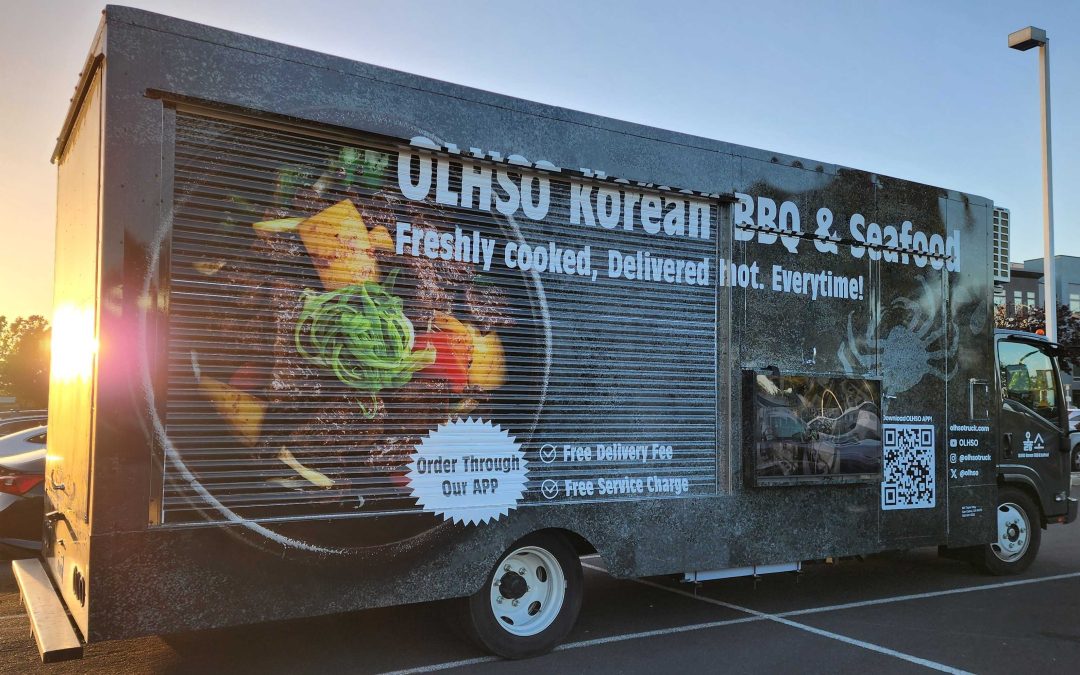It’s one thing to make an order through an app and wait for the food to arrive. It’s another to make an order through an app and wait for the restaurant to arrive. Such is the promise of OLHSO, which is a Korean BBQ & seafood food truck that uses robots in the truck to prepare your meal as it heads to your location. And if that isn’t a sentence that makes your head spin nothing will.

Charles Kim, COO of Shin Starr Presents
“The idea took us four and a half years to develop, from concept to launch,” said Charles Kim, chief operating officer of Shin Starr Presents, which operates OLHSO. “We now have two trucks on the streets in Foster City, California. When you make an order through the OLHSO app, it goes through to a dispatcher, who assigns it to the closest truck.”
Then the robots get to work. In its in-vehicle kitchen, one robot takes a canister of ingredients for one of five menu items, including Wagyu Galbi and Japchae, from a refrigerated unit and hands it off to another robot, who places it into one of four woks for cooking. Kim likens the process to that of a vending machine.
Once the meal is done cooking, it gets poured onto a bowl on a conveyer belt and brought to a window for picking up. The driver pops around to the back, does a little garnishing, packages the meal, and hands it off to the customer. The whole thing takes 15 to 20 minutes.
“We’ve designed the process so the food arrives hot and fresh,” Kim said.
Meals with meat go for between $45 and $55, with each order serving two to three people, while the vegetarian Japchae costs $25 for one to two people.
There still is a need for a human touch: someone to load in the ingredients, a driver, a dispatcher. But the stir-frying is done with proprietary cook-in-route technology that requires no one with red blood cells.
‘You’re right’
OLHSO means “you’re right” in Korean. When Kim explained the technology in 2021 to Tyler Kalin of food-truck booking vendor Roaming Hunger, that’s what he heard back.

Tyler Kalin of Roaming Hunger
“When they came to use with this wild idea of robotics, we thought of trying this in a food truck, which was something I was really interested in doing,” Kalin said.
But there were hurdles. Regulators threw them up as they didn’t know how to assess such a mobile restaurant. That’s because such a mobile restaurant had never existed.
“Food trucks are archaic in terms of regulation,” said Kalin, who has spent more than a decade in the industry. “We talked to all the regulatory bodies, from local health agencies to state to federal. We had to get a lot of people acclimated to this idea.”
Kim and Kalin are hoping Bay Area consumers get acclimated as well. Even for an innovation hub like Northern California, it’s an unusual idea. “It’s taking some time,” Kim said.
But he remains confident. He’s smart enough to know that for all the holy crap appeal of the automation, the true test of the proposition is in something simpler.
“The food. The food is our main focus. Of course we hope people see the truck as a way to reduce operational costs, but to us it’s always food first. We want to keep the quality of our ingredients high,” he said.
The tech is turning heads though.

Professor Dina Zemke of Ball State University
“I haven’t seen robots like this in a food truck,” said Professor Dina Zemke of Ball State University. Zemke teaches in the university’s business school and has authored a paper on robots in quick-service restaurants. “I don’t know if this truly is the first automated mobile restaurant but it seems plausible. I’m not sure how congested the traffic is in Foster City but things could get tricky if the business expands into more congested areas.”
Franchising the trucks
Kim and Kalin seem game to trying their hand in busier cities. They’re already talking about pointing future trucks down I-5 and exploring cities like Santa Clara and Los Angeles, which would seem a natural home. And then, who knows? The duo are hoping to use a franchise model to sign up interested parties. At the moment that might be a challenging sell. But it also could be that a restaurant wanting to reduce its cook-and-deliver time by doing both at once might find a truck entirely logical.
And there’s the hipness factor.
“We’re finding that the experience has a lot of appeal to young people,” Kalin said. “This really is a hot and fresh meal delivered right to your door, made by robots.”


